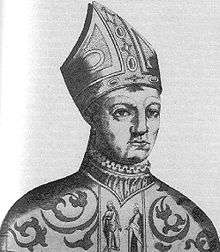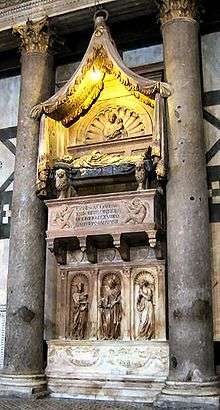Antipope John XXIII
| Antipope John XXIII | |
|---|---|
 | |
| Papacy began | 1410 |
| Papacy ended | 1415 |
| Predecessor | Alexander V |
| Opposed to |
Gregory XII (Roman claimant) Benedict XIII (Avignon claimant) |
| Personal details | |
| Born |
c. 1365 Procida, Kingdom of Naples |
| Died |
22 December 1419 (aged 48–49) Florence, Republic of Florence |
| Coat of arms |
|
| Other popes and antipopes named John | |
Baldassarre Cossa (c. 1370 – 22 December 1419) was Pisan antipope John XXIII (1410–1415) during the Western Schism. The Catholic Church regards him as an antipope, as he opposed the Pope whom the Catholic Church now recognizes as the rightful successor of Saint Peter. He was eventually deposed and tried for various crimes, though later accounts question the veracity of those accusations.
Early life
Baldassarre Cossa was born on the island of Procida or in the Kingdom of Naples to the family of Giovanni Cossa, lord of Procida. Initially he followed a military career, taking part in the Angevin-Neapolitan war. His two brothers were sentenced to death for piracy by Ladislaus of Naples.[1]
He studied law at the University of Bologna and obtained doctorates in both civil and canon law.[2] Probably at the prompting of his family, in 1392 he entered the service of Pope Boniface IX, first working in Bologna and then in Rome. (The Western Schism had begun in 1378 and there were two competing popes at the time, one in Avignon supported by France and Spain, and one in Rome, supported by most of Italy, Germany and England.) In 1386 he is listed as canon of the cathedral of Bologna. In 1396, he became archdeacon in Bologna. He became Cardinal deacon of Saint Eustachius in 1402 and Papal legate in Romagna in 1403. Johann Peter Kirsch describes Cossa as "utterly worldly-minded, ambitious, crafty, unscrupulous, and immoral, a good soldier but no churchman".[3] At this time Cossa also had some links with local robber bands, which were often used to intimidate his rivals and attack carriages. These connections added to his influence and power in the region.[4]
Role in the Western Schism
The Council of Pisa
Cardinal Cossa was one of the seven cardinals who, in May 1408, withdrew their allegiance from Pope Gregory XII, stating that he had broken his solemn oath not to create new cardinals without consulting them in advance. In company with those cardinals who had been following Antipope Benedict XIII of Avignon, they convened the Council of Pisa, of which Cossa became a leading figure. The aim of the council was to end the schism; to this end they deposed both Gregory XII and Benedict XIII and elected a new pope Alexander V in 1409.[3] Gregory and Benedict ignored this decision however, so that there were now three simultaneous claimants to the Papacy.
Election to the Papacy
Alexander V died soon after, and on 25 May 1410 Cossa was consecrated pope, taking the name John XXIII. He had been an ordained priest only one day earlier. John XXIII was acknowledged as pope by France, England, Bohemia, Portugal, parts of the Holy Roman Empire, and numerous Northern Italian city states, including Florence and Venice and the Patriarchate of Aquileia; however, the Avignon Pope Benedict XIII was regarded as pope by the Kingdoms of Aragon, Castile, Sicily and Scotland and Gregory XII was still favored by Ladislaus of Naples, Carlo I Malatesta, the princes of Bavaria, Louis III, Elector Palatine, and parts of Germany and Poland.[5] John XXIII made the Medici Bank the bank of the papacy, contributing considerably to the family's wealth and prestige.[6]
The main enemy of John was Ladislaus of Naples, who protected Gregory XII in Rome. Following his election as pope, John spent a year in Bologna and then joined forces with Louis II of Anjou to march against Ladislaus. An initial victory proved short-lived and Ladislaus retook Rome in May 1413, forcing John to flee to Florence.[3] In Florence he met Sigismund, King of the Romans. Sigismund wanted to end the schism and urged John to call a general council. John did so with hesitation, at first trying to have the council held in Italy (rather than in a German Imperial City, as Sigismund wanted). The Council of Constance was convened on 30 October 1413. During the third session, rival Pope Gregory XII authorized the council as well. The council resolved that all three popes should abdicate and a new pope be elected.[7]
Flight from the Council of Constance
In March, John escaped from Constance disguised as a postman.[7] According to the Klingenberger Chronicle, written by a noble client of Frederick IV, Duke of Austria, John XXIII travelled down the Rhine to Schaffhausen in a boat, while Frederick accompanied him with a small band of men on horseback. There was a huge outcry in Constance when it was discovered that John had fled, and Sigismund was furious about this setback to his plans for ending the Schism. The King of the Romans issued orders to all the powers on the Upper Rhine and in Swabia stating that he had declared Frederick to be an outlaw and that his lands and possessions were forfeit. In due course this led to a great deal of political upheaval and many Austrian losses in the region, notably in Aargau to the Swiss Confederation.
In the meantime, Pope John XXIII and Frederick fled further downriver along the Rhine to the town of Freiburg im Breisgau, which recognised the duke of Austria as its lord. There Sigismund's lieutenant Ludwig III, Elector Palatine caught up with them. He convinced Frederick that he stood to lose too much by harbouring the fugitive pope, and the Austrian duke agreed to give himself and John up and return to Constance.[8]
Deposition
During his absence John was deposed by the council, and upon his return he was tried for heresy, simony, schism and immorality, and found guilty on all counts. Gibbon wrote, "The more scandalous charges were suppressed; the vicar of Christ was accused only of piracy, rape, sodomy, murder and incest."[9] John was given over to Ludwig III, Elector Palatine, who imprisoned him for several months in Heidelberg and Mannheim. The last remaining claimant in Avignon, Benedict XIII, refused to resign and was excommunicated. Martin V was elected as new pope in 1417.
Death and burial
Cossa was again imprisoned in Germany. He was freed in 1418 after a heavy ransom was paid by the Medici.[6] He went to Florence where he submitted to Martin V who made him Cardinal Bishop of Frascati. Cossa died only a few months later.
The Medici oversaw the construction of his magnificent tomb by Donatello and Michelozzo in the Battistero di San Giovanni in Florence. Pope Martin V protested in vain against the inscription on the sarcophagus: "John the former pope".
J.P. Kirsch remarks that "Undeniably secular and ambitious, his moral life was not above reproach, and his unscrupulous methods in no wise accorded with the requirements of his high office ... the heinous crimes of which his opponents in the council accused him were certainly gravely exaggerated."[3] One historian concluded that John was "a great man in temporal things, but a complete failure and worthless in spiritual things".[1]
Numbering issues
He should not be confused with Pope John XXIII of the twentieth century. When Angelo Roncalli was elected pope in 1958, there was some confusion as to whether he would be John XXIII or John XXIV; he then declared that he was John XXIII to put this question to rest. There was no John XX; this is why Gibbon refers to the antipope John as John XXII.
References
- 1 2 Joseph McCabe (1916). "Chapter XI. John XXIII and the Great Schism". Crises in the History of the Papacy. G.P. Putnam's Sons. ISBN 978-0-7661-7904-2.
- ↑ Greenblatt 2011, Chapter 7.
- 1 2 3 4 Kirsch, Johann Peter. "John XXIII." The Catholic Encyclopedia Vol. 8. New York: Robert Appleton Company, 1910. 2 January 2016
- ↑ Greenblatt 2011, p. 158.
- ↑ Lightbown, R.W. (1980) Donatello & Michelozzo. London: Harvey Miller. Pp. 4–5.
- 1 2 "Popes and Prelates", Mediateca di Palazzo Medici
- 1 2 Miranda, Salvador. "Cossa, Baldassare", The Cardinals of the Holy Roman Church
- ↑ Brandmüller, Walter. Das Konzil von Konstanz, 1414-1418 (Paderborn, 1991-7)
- ↑ Gibbon, Edward. The Decline and Fall of the Roman Empire, New York: The Heritage Press, 1946, vol. 3, p. 2417
Sources
- Greenblatt, Stephen (2011). The Swerve: How the World Became Modern. W.W. Norton. ISBN 978-0393343403.
Further reading
In 1983 political satirist/novelist Richard Condon (The Manchurian Candidate) wrote A Trembling Upon Rome, a novel of historical fiction about the life of Baldassare Cossa.
| Wikimedia Commons has media related to Antipope John XXIII. |
